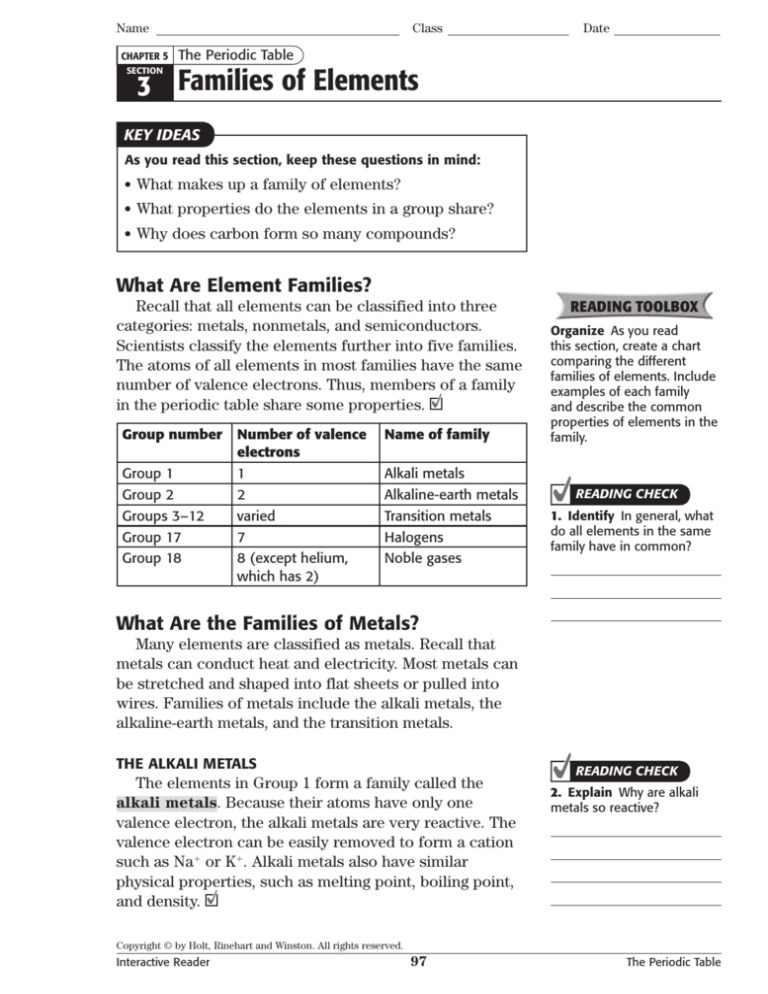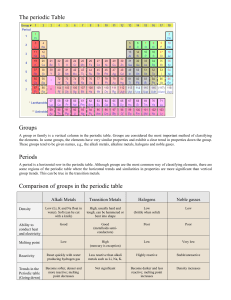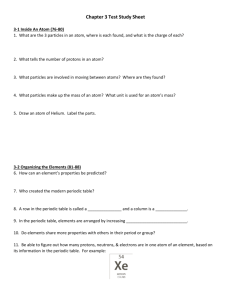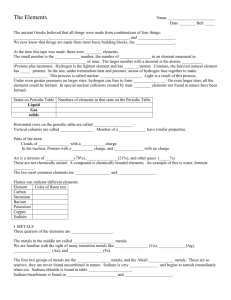
Name
CHAPTER 5
Class
Date
The Periodic Table
SECTION
3 Families of Elements
KEY IDEAS
As you read this section, keep these questions in mind:
• What makes up a family of elements?
• What properties do the elements in a group share?
• Why does carbon form so many compounds?
What Are Element Families?
Recall that all elements can be classified into three
categories: metals, nonmetals, and semiconductors.
Scientists classify the elements further into five families.
The atoms of all elements in most families have the same
number of valence electrons. Thus, members of a family
in the periodic table share some properties.
Group number
Number of valence
electrons
Name of family
Group 1
1
Alkali metals
Group 2
2
Alkaline-earth metals
Groups 3–12
varied
Transition metals
Group 17
7
Halogens
Group 18
8 (except helium,
which has 2)
Noble gases
READING TOOLBOX
Organize As you read
this section, create a chart
comparing the different
families of elements. Include
examples of each family
and describe the common
properties of elements in the
family.
READING CHECK
1. Identify In general, what
do all elements in the same
family have in common?
What Are the Families of Metals?
Many elements are classified as metals. Recall that
metals can conduct heat and electricity. Most metals can
be stretched and shaped into flat sheets or pulled into
wires. Families of metals include the alkali metals, the
alkaline-earth metals, and the transition metals.
THE ALKALI METALS
The elements in Group 1 form a family called the
alkali metals. Because their atoms have only one
valence electron, the alkali metals are very reactive. The
valence electron can be easily removed to form a cation
such as Na or K. Alkali metals also have similar
physical properties, such as melting point, boiling point,
and density.
READING CHECK
2. Explain Why are alkali
metals so reactive?
Copyright © by Holt, Rinehart and Winston. All rights reserved.
Interactive Reader
97
The Periodic Table
Name
SECTION 3
Class
Date
Families of Elements continued
Group 1
Alkali Metals
The alkali metals are found on the left edge of the periodic table.
READING CHECK
Because alkali metals are so reactive, they are rarely
found in nature as pure elements. Rather, they are found
combined with other elements as compounds. For example, the alkali metal sodium is found in the salt sodium
chloride, NaCl. Sodium chloride is more commonly
known as table salt.
3. Explain Why are alkali
metals rarely found as pure
elements?
Alkali metals, such as sodium, are so soft that they can be cut with a knife.
THE ALKALINE-EARTH METALS
READING CHECK
4. Describe Describe the
reactivity of alkaline-earth
metals.
The elements in Group 2 form a family called the
alkaline-earth metals. The atoms of alkaline-earth
metals have two valence electrons. These elements are
reactive, but not as reactive as alkali metals.
Copyright © by Holt, Rinehart and Winston. All rights reserved.
Interactive Reader
98
The Periodic Table
Name
SECTION 3
Class
Date
Families of Elements continued
Group 2
Alkaline-Earth Metals
The alkaline-earth metals are found in Group 2 in the periodic table.
Alkaline-earth metals form cations with 2 charges,
such as Mg2 and Ca2. The alkaline-earth metals combine
with other elements to form compounds. For example,
two magnesium compounds—milk of magnesia and
Epsom salts—are commonly used to treat minor
medical problems. In addition, many calcium compounds
are important to living things. Some make up the hard
shells of many sea animals. Calcium compounds also
make your bones and teeth strong.
8g^i^XVa I]^c`^c\
5. Apply Concepts Do
alkaline-earth elements gain
electrons or lose electrons to
form ions?
The stalagmites and stalactites in limestone caves contain calcium
carbonate deposits.
READING CHECK
THE TRANSITION METALS
An element located in Groups 3-12 is known as a
transition metal. Transition metals are not as reactive
as the alkali metals or the alkaline-earth metals. In fact,
some transition metals are quite unreactive.
6. Describe Describe the
reactivity of transition metals.
Copyright © by Holt, Rinehart and Winston. All rights reserved.
Interactive Reader
99
The Periodic Table
Name
SECTION 3
Class
Date
Families of Elements continued
Transition Metals
Group 3–12
EHHDBG@<EHL>K
7. Identify Where are the
transition metals located on
the periodic table?
The transition metals are located in the middle of the periodic table.
READING CHECK
8. Explain Why can transition metals form different
kinds of ions?
Although they are generally unreactive, transition
metals can form ions. For example, an atom of gold, Au,
can lose one electron to form Au or three electrons to
form Au3+. Some transition metals can form as many as
four different ions. Why? Transition metals have complex
arrangements of electrons that make them behave
differently than other elements.
Both gold and platinum
are shaped to make jewelry.
Like other metals, the transition metals are good
conductors of electricity and heat. Most transition metals
are harder, denser, and have higher melting points than
alkali and alkaline-earth metals. Mercury is an exception.
Mercury is the only metal that is a liquid at room
temperature. For this reason, mercury is used in some
thermometers.
Copyright © by Holt, Rinehart and Winston. All rights reserved.
Interactive Reader
100
The Periodic Table
Name
SECTION 3
Class
Date
Families of Elements continued
SYNTHETIC ELEMENTS
All elements with atomic numbers greater than 92 are
synthetic, or made in a laboratory. Technetium and
promethium have atomic numbers lower than 92, but
they are also synthetic elements. Synthetic elements are
radioactive. Radioactive elements decay, or break down.
They may become different elements.
Examine the periodic table in the back of the book.
Note that parts of Periods 6 and 7 are placed in two rows
at the bottom of the periodic table. Many of these elements are synthetic. These two rows are placed separately so that the rest of the periodic table stays narrow.
This placement also allows the other elements to line up
according to periodic trends.
Synthetic elements have various uses. Plutonium is
used to make nuclear weapons. Americium is used in
smoke detectors.
READING CHECK
9. Define What are synthetic
elements?
What Are the Families of Nonmetals?
Except for hydrogen, nonmetals are located on the
right side of the periodic table. Nonmetals include some
elements in Groups 13–16 and all the elements in Groups
17 and 18. Families of nonmetals include the noble gases
and the halogens.
THE NOBLE GASES
The elements in Group 18 form a family called the
noble gases.
Group 18
Noble Gases
EHHDBG@<EHL>K
10. Infer How many valence
electrons do noble gases
have? Explain your answer.
The noble gases are located along the right edge of the periodic table.
Copyright © by Holt, Rinehart and Winston. All rights reserved.
Interactive Reader
101
The Periodic Table
Name
SECTION 3
Class
Date
Families of Elements continued
Neon produces the bright
reddish orange light in neon
signs. Other gases are added to
make different colors.
READING CHECK
11. Explain Why do noble
gases exist as single atoms
rather than as compounds?
Unlike most elements, the noble gases exist as single
atoms, rather than as molecules or ions. Why? The
outermost energy level of a noble gas atom is filled. Thus,
noble gases are inert, or unreactive, and they do not
typically react with other elements to form compounds.
In other words, noble gases are very stable.
Because noble gases are inert, they can be useful in
many situations. For example, light bulbs are filled with
argon gas because argon will not react with the bulb’s
metal filament.
THE HALOGENS
8g^i^XVaI]^c`^c\
12. Infer Why do Na and
Cl readily combine to form
a compound?
The elements in Group 17 form a family called the
halogens. The halogens are the most reactive nonmetals. They are very reactive because each atom has
seven valence electrons. If it gains one electron, a halogen
atom becomes stable.
Halogens combine easily with alkali metals because
atoms of alkali metals need to lose one valence electron
to become stable. Halogens can also combine with other
metals. These combinations are called salts.
Some examples of common uses of halogens are
described below.
• A compound containing the fluoride ion, F, is added
to many toothpastes and water supplies. Fluoride helps
prevent tooth decay.
• A compound containing the iodide ion, I, is added to
table salt to make iodized salt. You need iodine in your
diet to help you stay healthy.
• A compound containing chlorine is added to swimming
pool and drinking-water supplies. Chlorine can kill
bacteria.
Copyright © by Holt, Rinehart and Winston. All rights reserved.
Interactive Reader
102
The Periodic Table
Name
Class
SECTION 3
Date
Families of Elements continued
Group 17
Halogens
Halogens are located in the second column from the right on the
periodic table.
HYDROGEN—A UNIQUE ELEMENT
Although hydrogen has one valence electron, it is not
a member of the alkali metal family. Hydrogen has only
one proton and one electron and has different properties
from other Group 1 elements.
Hydrogen is the most abundant element in the
universe. About three out of every four atoms in the
universe are hydrogen atoms. Most of these are located
in clouds of gas and stars.
With only one electron, hydrogen can react with many
other elements. For example, hydrogen reacts with oxygen to form water, H2O, which is essential to life.
READING CHECK
13. Explain Why is
hydrogen not considered
an alkali metal?
What Are the Semiconductors?
Recall that semiconductors can conduct electricity
under certain conditions. The family of semiconductors
contains six elements. These elements are not found in
one particular group. Instead, they are found in different
periods and groups.
READING CHECK
14. Describe What are
semiconductors?
Copyright © by Holt, Rinehart and Winston. All rights reserved.
Interactive Reader
103
The Periodic Table
Name
SECTION 3
Class
Date
Families of Elements continued
EHHDBG@<EHL>K
Semiconductors
15. Describe How does the
location of semiconductors
on the periodic table differ
from the locations of other
element families?
Unlike other families of elements, semiconductors are not found in
one group or in a block of groups. They are scattered among several
periods and groups.
OTHER NONMETALS
8g^i^XVaI]^c`^c\
16. Apply Concepts How
many electrons does an
oxygen atom gain to form an
oxide ion?
In addition to the noble gases and halogens, there
are six other nonmetals. Oxygen, nitrogen, and sulfur
are very common nonmetals. They may gain electrons
to form ions. For example, oxygen can form oxide, O2,
nitrogen can form nitride, N3, and sulfur can form
sulfide, S2.
Nitrogen and oxygen are the most plentiful gases in
air. Sulfur is an odorless solid. However, many sulfur
compounds, such as those in rotten eggs and skunk
spray, have a terrible smell.
Other Nonmetals
The remaining nonmetals are carbon, nitrogen, oxygen, phosphorus,
sulfur, and selenium.
Copyright © by Holt, Rinehart and Winston. All rights reserved.
Interactive Reader
104
The Periodic Table
Name
SECTION 3
Class
Date
Families of Elements continued
Graphite and diamond are both forms of carbon.
Carbon atoms can combine with one another in
different ways to produce very different compounds.
One way carbon atoms combine with one another
produces graphite, which is used in pencil “lead.”
Carbon atoms can combine in another way to form
diamonds.
Carbon atoms can also combine to form substances
called fullerenes. The most famous has 60 carbon atoms
and is known as buckminsterfullerene. The structure
of this substance looks like a geodesic dome that was
designed by American inventor R. Buckminster Fuller.
A geodesic dome is a structure that looks like a large
soccer ball.
Carbon can also combine with other elements to form
millions of different compounds. These carbon-containing
compounds are found in both living and nonliving things.
Carbon compounds found in living things include sugars
that you eat and chlorophyll in the cells of plants. Carbon
compounds in nonliving things include rubber and
isooctane in gasoline.
8g^i^XVa I]^c`^c\
17. Explain Why is it not
correct to refer to the material in pencils as “lead”?
Copyright © by Holt, Rinehart and Winston. All rights reserved.
Interactive Reader
105
The Periodic Table
Name
Class
Date
Section 3 Review
SECTION VOCABULARY
alkali metal one of the elements of Group 1 of
the periodic table (lithium, sodium, potassium,
rubidium, cesium, and francium)
alkaline-earth metal one of the elements of
Group 2 of the periodic table (beryllium,
magnesium, calcium, strontium, barium,
and radium)
halogen one of the elements of Group 17 of
the periodic table (fluorine, chlorine, bromine,
iodine, and astatine); halogens combine with
most metals to form salts
noble gas one of the elements of Group 18
of the periodic table (helium, neon, argon,
krypton, xenon, and radon); noble gases
are unreactive
transition metal one of the metals that can
use the inner shell before using the outer shell
to bond
1. Identify Which element is more reactive—lithium, Li, or beryllium, Be? Explain
your answer.
2. Infer Scientists store some reactive chemicals in containers filled with argon. Why?
3. Classify Complete the following table to describe several elements. Use the
periodic table in the back of the book to help you.
Symbol
Group number
Period number
Family name
Period 2
semiconductor
Period 6
halogen
Period 5
noble gas
Co
Mg
Group 2
4. Infer A particular substance is typically found in nature as a pure element. What
can you conclude about the reactivity of this element? (Hint: Which family
contains elements that are generally found as pure elements?)
Copyright © by Holt, Rinehart and Winston. All rights reserved.
Interactive Reader
106
The Periodic Table








